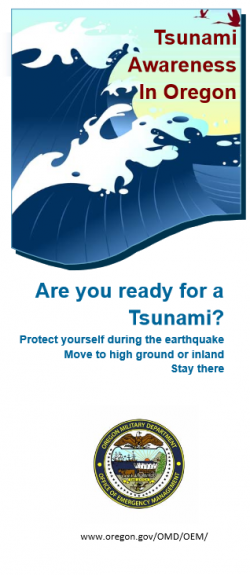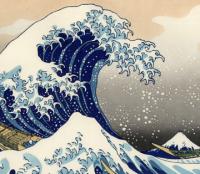Tsunami Preparedness and Response

Tsunami Awareness in Oregon - Are you Ready for a Tsunami? - view the pamphlet
What is a Tsunami?
The phenomenon called a "tsunami" is a series of traveling ocean waves of extremely long length and period, generated by disturbances associated primarily with earthquakes occurring below or near the ocean floor. Underwater volcanic eruptions and landslides can also generate tsunamis, although these sources are significantly less frequent.

As the tsunami crosses the deep ocean, sometimes at speeds exceeding 1,000 km/g (600 mph), its length from crest to crest may be 200 km (124 miles) or more and its period 15 minutes to an hour, but its height from trough to crest may only be a few tens of centimeters (a few inches or feet), even for a very destructive tsunami. It cannot be felt aboard ships or deep water. As the tsunami enters shallow water near coastlines in its path, the velocity of its waves decreases and its wave height increases. It is in these shallow waters that tsunamis become a threat to life and property, for they can crest to heights of more than 10 m (30 feet), strike with devastating force, and flood low-lying coastal areas.
How Tsunamis Are Formed
• Gravity pulls the offshore Juan de Fuca Plate beneath the North American Plate. Most of the time these plates are firmly stuck together along the boundary (red zone).
• Over time, the North American Plate is squeezed and bulges up as the Juan de Fuca Plate slowly tries to move beneath it.
• Eventually the stuck area can no longer resist the squeezing and breaks along the boundary, causing a large earthquake. Like a spring, the overriding North American Plate jumps upward and seaward, lifting the water above it. A tsunami is born.
• The water bulge divides and sends waves both east towards the coast and west into the Pacific Ocean. The first waves reach nearby shores only minutes after the earthquake. The other set of waves may still be large enough to damage distant coastal areas many hours later.
Who is at Risk for a Tsunami?
• Any resident, visitor, business, or facility on any beach or coastline.
Are you ready for a Tsunami?
• Protect yourself during the earthquake
• Move to high ground or inland
• Stay there
Did you know. . . ?
• In deep water, tsunami waves may reach speeds of 600 miles per hour
• Currents associated with tsunamis may reach up to 35 miles per hour
• Tsunamis may be generated from distant locations and may not be preceded by a local earthquake
The Oregon Coast
The Oregon Coast is at risk both from locally and distantly generated tsunamis. A local tsunami is created from a subduction zone earthquake off our coast that you may feel. A distant tsunami is from a subduction zone earthquake elsewhere that you would not feel.
Oregon is situated along the Cascadia Subduction Zone, a 600 mile long earthquake fault stretching from offshore northern California to southern British Columbia. This fault builds up stress for hundreds of years as the Juan de Fuca and North Pacific Plates push against each other. Eventually, the two plates rip apart, creating some of the largest earthquakes and tsunamis on earth.
Where Should I Go?
All Oregon coastal counties have tsunami Hazard guidance maps and are in the process of posting tsunami hazard zone signs. These signs and maps will show you what areas are safe and what areas may be at risk. Use them to guide you to a safe area.
If no maps or signs are available, go to an area 100 feet above sea level or two miles inland, away from the coast. If you cannot get this far, go as high as possible. Every foot inland or upwards can make a difference.
Tsunami Warning Centers 4 Levels of Messaging
1) Warning: A potential tsunami with significant widespread inundation is imminent or expected. Widespread, dangerous coastal flooding accompanied by powerful currents is possible and may continue for several hours after the arrival of the initial wave
2) Advisory: A potential tsunami which may produce strong currents or waves exists. Significant widespread inundation is not expected.
3) Watch: A potential dangerous distant seismic event has occurred which may later impact the watch area with a tsunami. Be ready to take action if a warning is issued.
4) Information Statement: An earthquake has occurred or a tsunami warning, watch, or advisory has been issued for another section of the ocean. In most cases, information statements are issued to indicate there is no threat of a destructive tsunami in your area.
Tsunami Safety Rules
1) All earthquakes do not cause tsunamis, but many do. When you hear that an earthquake has occurred, stand by for a tsunami emergency message.
2) An earthquake in your area is a natural tsunami warning. Don not stay in low-lying coastal areas after a strong earthquake has been felt.
3) A tsunami is not a single wave, but a series of waves. Stay out of danger areas until an "all-clear" is issued by a competent authority.
4) Approaching tsunamis are sometimes preceded by a noticeable rise or fall of coastal water. This is nature's tsunami warning and should be heeded.
5) A small tsunami at one point on the shore can be extremely large a few miles away. Don't let the modest size of one make you lose respect for all.
6) All warnings to the public must be taken very seriously, even if some are for non-destructive events. The tsunami of May 1960 killed 61 people in Hilo, Hawaii, because some thought it was just another false alarm.
7) All tsunamis, like hurricanes, are potentially dangerous, though they may not damage every coastline they strike.
8) Never go down to the shore to watch for a tsunami. When you can see the wave you are too close to escape it. Never try to surf a tsunami; most tsunamis are like a flash flood full of debris and they do not curl or break like surfing waves.
9) Sooner or later, tsunamis visit every coastline in the Pacific. Warnings apply to you if you live in any Pacific coastal area.
10) During a tsunami emergency, your local civil defense, Police, and other emergency organizations will try to save your life. Give them your fullest cooperation.
What You Can Do To Prepare

How you prepare will affect how you recover. And being prepared for earthquakes and tsunamis prepares you for all kinds of disasters.
• Know if you live, work, or play in a tsunami hazard zone.
• Learn what the recommended tsunami evacuation routes are in your city, county, and region. Identify safety zone(s) near you, and decide on your primary and secondary evacuation routes.
• If you live or work in a tsunami hazard zone get a NOAA weather radio with the public alert feature for your home and office. It will alert you even if turned off.
• Assemble a small evacuation kit with essential documents, medications, a flashlight, a portable NOAA weather radio and batteries, water, snacks, and warm clothes. Include a silver "space blanket" in your kit – it can be used to signal your location to air search teams. Keep your evacuation kit by the door so you can "grab & go".
• Walk your route – consider what you would do at night or in stormy weather.
• Make a reunification plan with your loved ones. Decide when and where you will meet if you are separated and what out of state relative or friend you will call if it is not possible to meet at your pre-designated reunification spot.
• Discuss plans with family, coworkers, and neighbors.
• Make plans for how to address any functional needs or disabilities you might have. If you need help evacuating, prearrange assistance from neighbors including transport of mobility devices and durable medical equipment. If you are mobility impaired, account for the extra time that you may need.
• Decide on the best strategy for protection your pets.
• Prepare to be on your own for several days or longer.
• Consider joining your local Community Emergency Response Team (CERT).
For More Information see:
